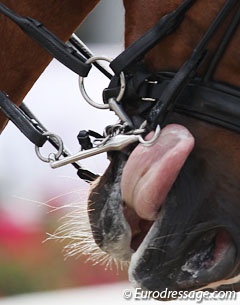
Contact issues are a recurrent problem in the dressage ring, from the grassroots to the top levels, even at the World Cup Finals, World Equestrian Games and Olympics. Tongue problems, going from tongues showing slightly on the side to 20 centimeters of flesh hanging out of the mouth as well as an ensuing blood running from the mouth after a tongue or lip was bitten, have brought entire judging panels off balance.
Though in principle the rules are clear about the tongue showing in dressage tests, scores of individual jugdes oscillate with a 10% difference. Tongue problems are usually the externalisation of incorrect training, often cloaked by tightly strapped nosebands. The modus vivendi has always been that once blood is seen in the horse's mouth, automatic elimination follows as the welfare of the horse is absolute priority.
Recent discussions between stakehoulders and the FEI Dressage Committee (DC) have prompted the DC to propose a rule change in which blood will be accepted at top level competitions as long as the horse is checked by an FEI vet outside the show ring when blood appears. If the blood has stopped running by the time the FEI vet is on the spot the horse will get a new chance to complete his test. Is this a wise decision beneficial for the welfare of the horse or just another means of regulating and allowing training issues to be tolerated in the show ring?
The Tongue, a Judging Enigma?
At the 2011 CDIO-PJYR Roosendaal a horse with his tongue showing on the left side the entire ride unbalanced the judges in producing a unanimous verdict. The ride scored 69%, 70% and 61%. The nine percentage difference led to much aggrevation amongst parents, trainers and riders as it became unclear what the standard should be. Was this a great ride, deserving 70%, or not. Was this presentation admirable or did it reveal a training issue?
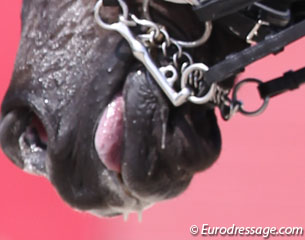 The FEI handbook for judges is very straightforward when it comes to scoring tongue issues. "I am afraid the judge who was lower was the right one in this case," O-judge Enzo Truppa told Eurodressage. "If the tongue is further taken out to one side, than every movement will be marked with 2 points less than otherwise deserved and if the tongue is out for most of the time the maximum mark is a 5 with corresponding sanction also in the collective marks."
The FEI handbook for judges is very straightforward when it comes to scoring tongue issues. "I am afraid the judge who was lower was the right one in this case," O-judge Enzo Truppa told Eurodressage. "If the tongue is further taken out to one side, than every movement will be marked with 2 points less than otherwise deserved and if the tongue is out for most of the time the maximum mark is a 5 with corresponding sanction also in the collective marks."
British O-judge Stephen Clarke explained that "tongue/mouth issues come in very many different guises, varying from the tongue being over the bit and stuck out to the side with about six inches of it waving about for all to see," he said. "In this case I'm sure that it would be noticed and marked down by all of the judges within each movement that it happened as well as the collective mark for submission."
Clarke admitted that the less serious version, where the tongue is just slightly visible to one side without it being over the bit, is a more difficult one to call. "It may not be visible to all judges throughout each of the test movements, particularly those who could only see some of the exercises from the right hand side of the horse," said Clarke. "Also it may not have been, if the rest of the picture was really good, considered as a really strong resistance (some horses will, a bit like school kids do when they are writing, push the tongue a tiny bit to the side in concentration rather than resistance). Therefore I can well imagine that one or two judges could easily pick up on this point more than others to whom it would have been less visible. But there again, that's exactly why there are five/seven judges placed around the arena."
Both Truppa and Clarke were fair by saying that it's hard to assess a situation, as the Roosendaal one, when they weren't there. However, the bottom line is that if the tongue is visible we must consider that the acceptance of the bridle is less than perfect and penalise appropriately as stated in the FEI Handbook," Clarke concluded.
The Taming of the Tongue
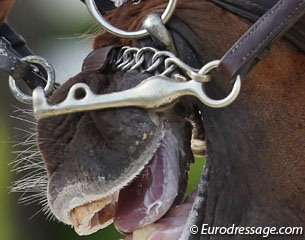 The quick fix for tongue issues (in competition) is to tighten the noseband more firmly and/or dropping it lower than normal. However, a constricting noseband is often visible as the horse will flare its nostrils due to breathing problems and the tongue will not be lolling out of the mouth but is just showing on the side (often discoloured as the blood stream is limited due to bit pressure).
The quick fix for tongue issues (in competition) is to tighten the noseband more firmly and/or dropping it lower than normal. However, a constricting noseband is often visible as the horse will flare its nostrils due to breathing problems and the tongue will not be lolling out of the mouth but is just showing on the side (often discoloured as the blood stream is limited due to bit pressure).
FEI Judge General Ghislain Fouarge stressed that a long-term showing of the tongue for the larger part of a dressage test is a "serious mistake to the basis" of dressage training. "The horse will first try to reduce the pressure by opening his mouth and if that is too much for him he'll push the tongue out," Fouarge told Eurodressage. "If the noseband is pulled so tightly that it will become impossible for the horse to do this, the problem remains the same in principle. The pressure of the bit on the tongue is so big that the horse is trying to defend itself against it."
Of course any rider can deal with a moment of stress in a test, a moment when extra pressure from the hands on the bit occurs and the horse showing his tongue briefly as a result. "Incidentally this can happen for a very short period of time, for instance when a horse jumps to the side because it spooks," Fouarge explained, adding that "it should not be for a longer period, otherwise the horse is not ready for what is asked from him. He won't have enough self carriage."
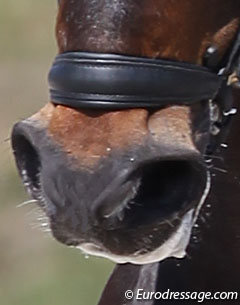 A good self-carriage is necessary for a horse to accept the bit and be light in the bridle. "This can only be obtained when the horse is trained in the right way and has been learnt to carry himself in the right way," Fouarge stated. "For him there will be no need to resist against the rider's hands. He will be happy because there is no unnecessary pressure on him. In the end the horse should find the contact with the bit pleasurable."
A good self-carriage is necessary for a horse to accept the bit and be light in the bridle. "This can only be obtained when the horse is trained in the right way and has been learnt to carry himself in the right way," Fouarge stated. "For him there will be no need to resist against the rider's hands. He will be happy because there is no unnecessary pressure on him. In the end the horse should find the contact with the bit pleasurable."
Fouarge is very aware of the fluctuating points judges give to horses with tongue issues. "It is tricky," Fouarge admitted. Especially because one should look if a tongue issue is being camouflaged by a tight noseband. "You have to know if the noseband is too tight and the person who should check it is the steward and he only does it after the test."
At the 2010 Global Dressage Forum it was suggested that it could be beneficial for the sport if the tightness of the noseband would be checked PRIOR to the test instead of afterwards (which is hardly done either). "Indeed I agree," said FEI Judge General Fouarge. "Beforehand and not afterwards," he added. "This is maybe an interesting item to think about."
Blood Diamonds Make New Blood Rules
At the 2010 World Equestrian Games dressage rider Adelinde Cornelissen and eventer Karim Florent Laghouag were eliminated because blood was detected in their horse's mouth during dressage competition. However, in early spring of 2011 Horse International brought to light the FEI dressage rules do not explicitely mention elimination in case of blood during a test. The sight of blood immediately triggers alarm bells for poor animal welfare and the FEI also resorts to their general rule (article 430.7.6) which states that a reason for elimination is if, “the performance is against the welfare of the horse.”
 “It is correct that blood is not specifically mentioned in the FEI Rules for Dressage Events,” FEI Dressage director Trond Asmyr told The Chronicle of the Horse in March 2011. “However, they provide the ground jury with the authority to eliminate horses for veterinary reasons, and clearly bleeding from the mouth is a veterinary issue. In the case of Parzival, the bleeding occurred during the test when the horse and rider were under the control of the judge at C. Elimination in these circumstances is immediate and is not appealable. It is accepted that blood in the mouth renders the horse unfit to compete, just as lameness does. Even if either is only temporary, the horse will still be eliminated. It is a general rule, and this is a specific application of it. It is difficult to include in a rulebook provisions for every single situation that may occur in a competition,” Asmyr continued. “We have in place solid rules to protect the horse, and eliminating a horse with blood is a well-established practice.”
“It is correct that blood is not specifically mentioned in the FEI Rules for Dressage Events,” FEI Dressage director Trond Asmyr told The Chronicle of the Horse in March 2011. “However, they provide the ground jury with the authority to eliminate horses for veterinary reasons, and clearly bleeding from the mouth is a veterinary issue. In the case of Parzival, the bleeding occurred during the test when the horse and rider were under the control of the judge at C. Elimination in these circumstances is immediate and is not appealable. It is accepted that blood in the mouth renders the horse unfit to compete, just as lameness does. Even if either is only temporary, the horse will still be eliminated. It is a general rule, and this is a specific application of it. It is difficult to include in a rulebook provisions for every single situation that may occur in a competition,” Asmyr continued. “We have in place solid rules to protect the horse, and eliminating a horse with blood is a well-established practice.”
The lack of clear regulations for the dressage discipline concerning blood have prompted the members of the International Dressage Trainers Club (IDTC) to revise the rules and propose changes. Spearheaded by Cornelissen's trainer Sjef Janssen, an IDTC board member, the trainers' club has formulated a new concept and rule for bloody mouths. In March The Chronicle of the Horse posted the IDTC rule proposal as following:
“Horses: evidence of blood in the competition arena; this may or may not be a welfare issue and will be reviewed case by case. If the chief Judge or Steward observes any bleeding, the test will be paused. The competitor shall leave the arena, and the Steward and FEI Veterinarian will immediately examine the athlete. In minor cases if the bleeding has stopped and it is deemed that there is not a horse welfare issue thus the horse is fit for competition; the athlete will be allowed to continue the test at the next break or at the end of the class. As with malfunctions of sound systems during the Kür, the test will be resumed at the point it was halted and all previous scores for movements will be maintained. In instances in the warm-up arena, the Steward may, at his discretion, call for the FEI Veterinarian to examine the horse to exclude any horse welfare issue and confirm fitness for competition.”
The IDRC Does Not Agree with the IDTC
Kyra Kyrklund, president of the International Dressage Riders Club (IDRC), told Eurodressage that the IDRC does not agree with the IDTC's suggestion. "Our viewpoint is that if there is blood in the mouth in the competition, the horse should be eliminated," she told Eurodressage. "The rider should have the right to appeal if s/he feels it was not blood and in that case have the chance to start again." The appeal would only apply if the rider thinks there is no blood. "I don't think they should get a second chance if it is blood," Kyrklund added. "The appeal is a right the rider should have. What if the judge is seeing something that isnt there? In Kentucky they (the FEI stewards) felt the sides of the horses after the test with a white glove. One horse had sweat and brown from dirt, not blood, and the stewards were very upset until they figured out what it was."
Kyrklund disclosed that the IDTC rule suggestion involves too many practical problems to make it feasible. "Shows don't have an FEI vet "on guard" by the dressage arena all the time," she stated. "What if the horse starting last in the competition starts to bleed. There are no pauses left. When should that one start again? And how much warm up time would be allowed for a re-start? What if the horse starts to bleed again, can it have a third go?"
Kyrklund is very realistic in identifying the impossibility of the IDTC proposal. She compared the accidental bleeding of a horse's mouth with a horse becoming unlevel due to a minor accident. "This can be compared with the possibility that a horse knocks itself on a nerve in the arena. That usually only causes lameness for a very short time. It is bad luck but should that one get a second chance too," she questions.
The 59-year old Kyra, who is a six-time Olympian, the 1991 World Cup Winner, a highly respected dressage trainer and professor at the Uppsala University of Agricultural Sciences, added that the biting of the lip or tongue is rarely accidental, but more often a way of revealing a training issue. "I believe that a horse that is relaxed and calm and in self-carriage does not bleed from the mouth," she said.
"A Little Water Will Clear Us of This Deed"
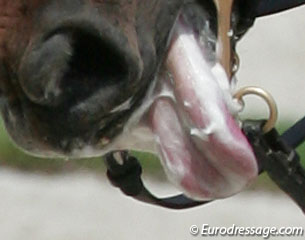 On Friday 24 June the FEI released a statement on the five key developments the FEI Dressage Committee (DC) is working on. It came as a shocking surprise that the DC has decided upon proposing the following rule to the National Federations for approval in order to get it passed at the 2011 FEI General Assembly in Rio de Janeiro, Brazil, in November.
On Friday 24 June the FEI released a statement on the five key developments the FEI Dressage Committee (DC) is working on. It came as a shocking surprise that the DC has decided upon proposing the following rule to the National Federations for approval in order to get it passed at the 2011 FEI General Assembly in Rio de Janeiro, Brazil, in November.
At top level events (Olympic Games, Championships and Finals for seniors), where FEI vets will be present at the warm-up arena, they would examine the horse and the test would resume if bleeding from minor injuries had stopped. If the bleeding had not stopped, the horse would be eliminated. Where vets are not present to examine the horse, bleeding would result in immediate elimination.
The proposed rule is restricted to top level events so only to the benefit of the world's elite riders. Any bleeding of a tongue bite will have stopped by the time the horse has left the arena (unless the horse actually chewed off part of his own lip or tongue). Furthermore, the FEI vet normally does not stand ring side the entire time. When a vet is called to duty at a huge international championships any minor bleeding will have stopped by the time the vet has waded through the crowds to reach the arena. In addition, this vet will have to show strong will of character to be able to speak against the opinion of riders, trainers and grooms who will be surrounding the horse and could even manipulate the bleeding to stop it sooner. It has happened before that the authority of FEI Stewards, even judges, has been undermined at international championships by authoritive, intimidating team members who think otherwise.
The Dressage Committee's decision to propose this rule to the national federation is also proof that the DC has completely ignored the ipinion of the IDRC. The recommendation of the IDRC Board was officially stipulated as following:
The IDRC believes that the welfare of the horse is paramount on all occasions and in all respects. If blood is observed by the President of the Ground Jury during a competition the the combination should be stopped and eliminated. In the interests of fairness, the rider should have the right to appeal. If the appeal is upheld on the basis that blood was not present then the test should continue at the point where it was stopped.
To be clear:
- If blood is found by the steward after the combination leaves the arena the rider should not be eliminated. However, the show veterinarian will be notified and the horse’s fitness to continue will be assessed.
- If blood is found prior to the competition, the combination will be allowed to compete if the cause and symptoms can be ameliorated.
It is the opinion of the IDRC that this is not a dressage issue but a horse welfare issue and should apply to all equestrian sports. Exceptions to this rule should be discipline specific where the decision is supported by evidence by appropriate healthcare professionals.
The IDRC would like to see an expert group comprising a rider, trainer, judge, steward, veterinarian and other experts as the FEI sees fit. The Clubs should nominate their representatives.
"The job of the expert group would be make sure that the draft of the rule reflects the needs of the sport. It is important that we get this right," said IDRC secretary-general Wayne Channon.
Eurodressage contacted two IDTC staff members for a reaction but did not receive a reply.
Tongue Twister
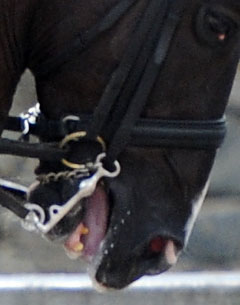 While the FEI dressage rules certainly need to be amended with a detailed language describing the elimination of a combination when blood is detected in the horse's mouth, the IDTC rule is an unacceptable version, firstly because of its impracticality and secondly because it gives even more leeway to training issues being accepted in the show ring.
While the FEI dressage rules certainly need to be amended with a detailed language describing the elimination of a combination when blood is detected in the horse's mouth, the IDTC rule is an unacceptable version, firstly because of its impracticality and secondly because it gives even more leeway to training issues being accepted in the show ring.
The public outcry for unison in the judges' corps is bigger than for detailing the blood rule which already resorted under the animal welfare rule. Unanimity in the scoring of a visible tongue, especially for the subtle cases where a (blue) tongue is visible because the horse is not accepting the bit or because the noseband is too tight, are of a more pertinent matter.
The FEI has been working hard on empowering the stewards the past two years, but this period of reform seems to have plateaued. O-judge Fouarge hit the nail on the head when he suggested that many tongue issues, even the "accidental" biting of the tongue, could be revealed and/or prevented by checking the noseband before entering the ring.
As memory is fleeting with the years, it is always nice to end by reproducing the FEI rules which are the guidelines and goal of our sport. The FEI's code of conduct states that "at all stages during the preparation and training of competition horses, welfare must take precedence over all other demands" and "abuse of a horse using natural riding aids or artificial aids (e.g. whips, spurs, (nosebands!) etc.) will not be tolerated." The ultimate goal of dressage is "the development of the horse into a happy athlete through harmonious education. As a result, it makes the horse calm, supple, loose and flexible, but also confident, attentive and keen, thus achieving perfect understanding with the athlete. These qualities are demonstrated by the acceptance of the bit, with submissiveness/throughness (Durchla?ssigkeit) without any tension or resistance" amongst other.
I rest my case.
-- Astrid Appels
info@eurodressage.com